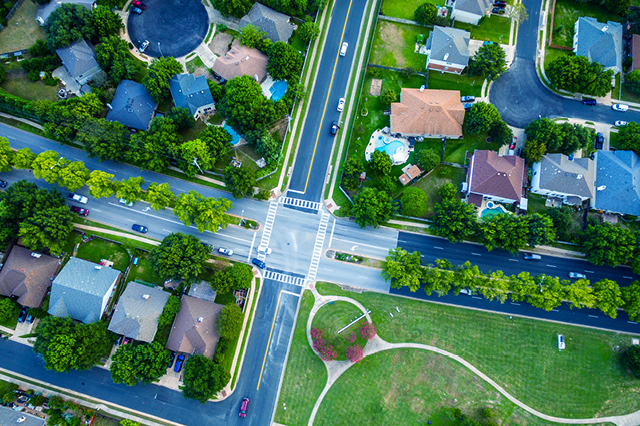What our communities will look like in a post-pandemic world
As cities grapple with how to open up following months of COVID-19 forced lockdowns, establishing '20-minute neighbourhoods' or suburban hubs could be an answer. It would ease immediate concerns regarding work, access to services and recreation and also serve as an attractive longer-term planning goal to achieve sustainable and resilient cities in a post-pandemic world.
What are 20-minute neighbourhoods?
20-minute neighbourhoods are suburban hubs based on the idea that people should have access to employment, recreational activities and essential goods and services within 20 minutes of their home, predominantly by walking but also by cycling or using public transport. In addition to the convenience of proximity and lifestyle benefits, the 20-minute neighbourhood also targets congestion on our roads, reduces emissions and promotes cleaner air.
This contrasts with the inconvenience and drawbacks of the current 'hub and spoke' approach of major Australian cities. This is where jobs, amenities and services are concentrated in and around a tight CBD cluster with radial transport networks designed to ferry its population to the centre.
The suburban hub is not a new concept. The 20-minute neighbourhood is a key component of the Victorian Government's 'Plan Melbourne' 2017-2050 planning strategy1 and is expressly recognised in the Guidelines for Precinct Structure Planning in Melbourne's Greenfields.2 In NSW, the government's Greater Sydney Region Plan: A Metropolis of Three Cities3 sets out a vision of three major cities within Greater Sydney where people live within 30 minutes of their jobs, education, health facilities, services and popular places.
The influence of COVID-19
COVID-19 and its associated restrictions on movement have reinforced the importance of having businesses, services and amenities in close proximity to home. In the most extreme instance, Melburnians under Stage 4 restrictions were prohibited from travelling more than 5km from their homes for shopping or exercise.
The pandemic has prompted a change in our preferences and behaviour. Many of us are more reluctant to enter crowded, enclosed spaces, including office buildings and public transport. We are also now more attracted to large open spaces and parks for outdoor dining, shopping and recreation.
In short, the pandemic has forced many of us to socialise, exercise and work in our local area.
Moving towards 20-minute neighbourhoods
Support for suburban hubs has already been reinvigorated elsewhere as a result of the pandemic, including in Milan (Italy), Paris (France) and Portland (USA), where they are embracing a variation – the '15-minute city' – as part of their recovery from COVID-19.4
As Australia shifts into a spending blitz on infrastructure to boost our economy, what can we do to better support the delivery of 20-minute neighbourhoods in Australia?
How are we faring closer to home? While some inner suburbs in Australia's capital cities already enjoy the benefits of 20-minute neighbourhoods such as Richmond and Carlton in metropolitan Melbourne, few areas in the outer suburbs of Australia's capital cities meet the 20-minute neighbourhood test.5
As Australia shifts into a spending blitz on infrastructure to boost our economy, what can we do to better support the delivery of 20-minute neighbourhoods in Australia?
Drawing upon some recent Melbourne-based pilot programs,6 our view is that the following mechanisms are critical:
- integrated whole-of-government place-based planning, across all levels of government (including state agencies and local council);
- delivering tailored solutions that address unique local needs; and
- developing community partnerships and neighbourhood projects to increase local participation and engagement.
We believe the following steps would better facilitate the implementation of 20-minute neighbourhoods moving forward in a post-COVID world:
1. Mandatory decision-making guidelines
The above concepts and ideas should be implemented and made part of the mandatory decision-making guidelines for strategic and statutory planning, transport and infrastructure (eg prioritising public transport projects that increase capacity and usability, and mandating walking and biking infrastructure alongside road projects, particularly in planning for greenfield developments and brownfield redevelopments). The Suburban Rail Loop Strategic Assessment reflects this and specifically highlights that linking the middle and outer corridors of Melbourne presents opportunities to create new 20-minute neighbourhoods.
2. Streamlined approval process
Implementing a streamlined approval process for developments that will contribute towards delivering 'best practice' 20-minute neighbourhoods, such as through the Victorian Government's Development Facilitation Program.
3. Collaboration across the board
Creating 20-minute neighbourhoods is a long-term commitment and will require collaboration across various levels of government, community, industry and business stakeholders. For example, in existing neighbourhoods, it is essential that local councils and the community are consulted to identify walkability and infrastructure gaps in order for a tailored solution to be developed.
Done well, the 20-minute neighbourhood has the potential to stimulate our economy in the short term, and protect day-to-day life in the long term against future health crises while also improving the way we live, work and play.
Footnotes
-
C40 Mayors' Agenda for a Green and Just Recovery, 30-31.







